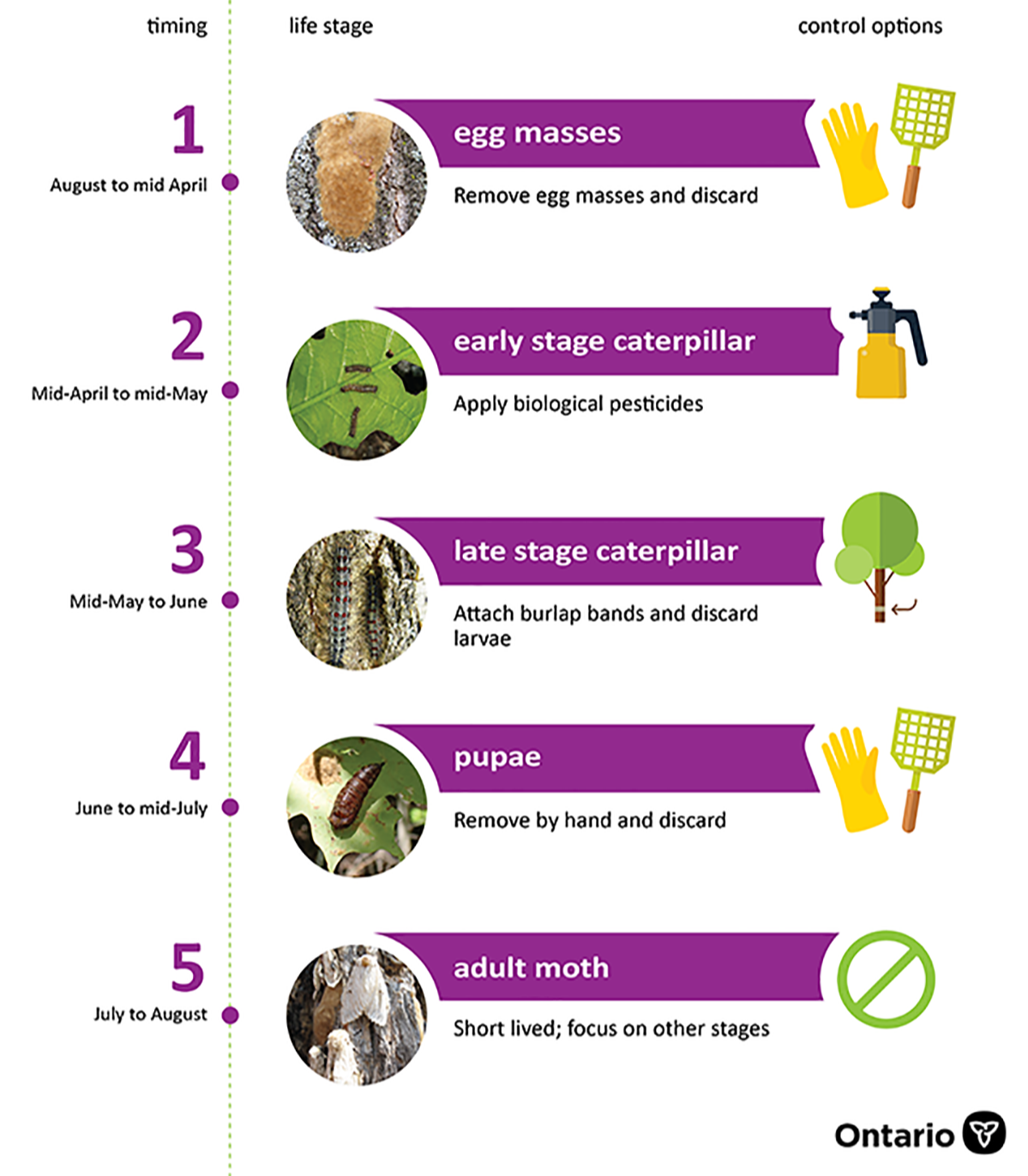Spongy (LDD) Moth
The spongy moth, previously referred to as European gypsy moth or by its scientific name of Lymantria dispar dispar (LDD), is a non-native invasive insect. Spongy moths prefer to feed on oak tree leaves, but will eat the leaves of more than 400 species of plants. Spongy moth outbreaks in Ontario are cyclical, happening every seven to ten years with peak infestations lasting 1 to 3 years.
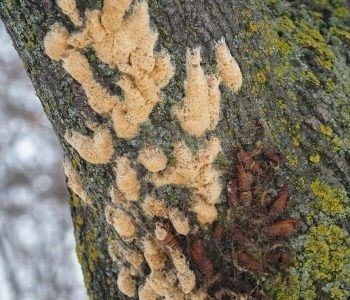
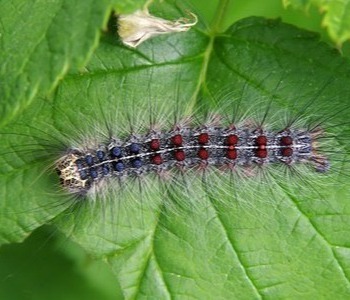
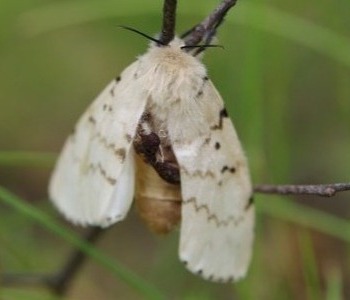
How to identify the spongy moth |
|
Egg massEgg masses are tan in colour, between the size of a dime and toonie. They are usually in tree bark crevices or other hidden places. It’s common to find them on vehicles, garbage cans, firewood piles, outdoor furniture and children’s toys. CaterpillarCaterpillars start off very small (about 2 mm) and molt three to four times, growing larger each time. By the time they reach their last molt, caterpillars can be 5-6 cm long. They are dark and hairy, with five blue and red dot pairs on the back. PupaAt the end of the caterpillar stage, the larvae seek safe shelter to pupate. Adult mothFemale moths are white with dark markings and cannot fly. Male moths are light brown with dark markings and can fly. |
History of the spongy moth |
|
The spongy moth is an invasive species that is native to Europe. It arrived in North America as a result of a misguided attempt to create a domestic silk industry. It was first detected in Ontario in 1969. Its presence was met with alarm as the impact of defoliation became apparent. This defoliator feeds on a variety of hardwood species, preferring oak, birch, and aspen. During severe outbreaks, softwoods such as eastern white pine, balsam fir, and Colorado blue spruce may be affected. Recent evidence, however, shows that spongy moths are behaving more like a native pest than an invasive species. This is due, in part, to the presence of several natural factors that help to regulate the population. |
Local impacts of the spongy moth
An outbreak began in Simcoe County in 2019, and widespread defoliation happened in 2020. In 2021, some areas within Simcoe County saw minimal defoliation while other locations suffered severe impacts for a second year. The County's report on the spongy moth situation includes egg mass survey results and information for municipal decision-making. The report states that although there will continue to be problematic areas throughout Simcoe County in 2022, it is clear that the overall trend of the spongy moth outbreak is in decline.
We're focusing on our efforts on increased communication about the spongy moth so property owners can take informed action to protect their trees. Read our report to Council for more information.
Managing spongy moths at home
Property owners are responsible for managing trees (and pests) on their property. There are a number of ways you can manage the impacts, but control options depend on the spongy moth life stage and the time of year.
Always wear gloves when handling caterpillars, egg masses and pupa to avoid an allergic reaction.
Keeping your trees healthy
Keeping your trees healthy will minimize the impact of spongy moth defoliation stress. Learn more about protecting trees on your property on the Province of Ontario's website.
Frequently asked questions
Review our frequently asked questions for more information.
Why isn't the Town doing aerial spraying? |
|
The County of Simcoe's research and resulting forecast predicts the spongy moth outbreak is in decline. The report did not recommend aerial spraying for county forests or municipal woodlands for several reasons. TimingAerial sprays require precise timing to be effective. Sprays require two applications within a very narrow time frame, which need to happen right after the caterpillars emerge and require specific weather conditions. CostAerial spraying over urban/residential areas is highly specialized and requires federal and provincial permits. Innisfil staff have limited capacity and in-house expertise to execute aerial spraying given the constraints of such work. Contracting out the service comes with a expensive price tag. LogisticsDespite the well-established safety record of Btk, some residents will oppose its use, creating logistical challenges where enough properties must be eliminated from spray blocks. Natural controlsThere are natural controls on spongy moth populations in Ontario, including:
These natural controls contribute the most to keeping levels within a normal range and tend to follow 2-3 years after the spongy moth populations peak. |
Can spongy moth caterpillars cause allergic reactions? |
|
Histamine found in the spongy moth caterpillar’s hair can cause red, itchy bumps to form. While the rash is not contagious, it can be quite uncomfortable. Wearing a hat, gloves, long sleeves and long pants can help protect your skin from coming into contact with the hairs. When handling caterpillars, egg masses and pupa always wear gloves to avoid an allergic reaction. If you are experiencing any sort of reaction, please contact your family care physician for medical advice. |
How do I scrape egg masses? |
|
Please review this How To Sheet from the Invasive Species Centre for information on properly scraping and disposing of spongy moth egg masses. |
Where can I purchase burlap? |
|
We are not providing burlap for property owners. It is more readily available at local hardware stores and comes in different formats and sizes to meet your individual needs. Watch this video from the City of Toronto for more information on using burlap to trap caterpillars. |
How much damage can spongy moths cause? |
|
Spongy moth caterpillars eat the leaves of trees, defoliating them. While most healthy trees can withstand several years of severe defoliation, trees that are already in poor health may have a harder time recovering. Additional stressors such as other pests and diseases or hot, dry weather may result in tree decline or death. If you're considering chemical treatments such as Btk-based products or TreeAzin, be aware that the effectiveness of these treatments at controlling the spongy moth is extremely time-sensitive. We recommend you consult with a private arborist as early as possible to allow the arborist time to properly schedule the work. |
Resources
Check out the below organizations to learn more about the spongy moth and how you can manage them on your property:

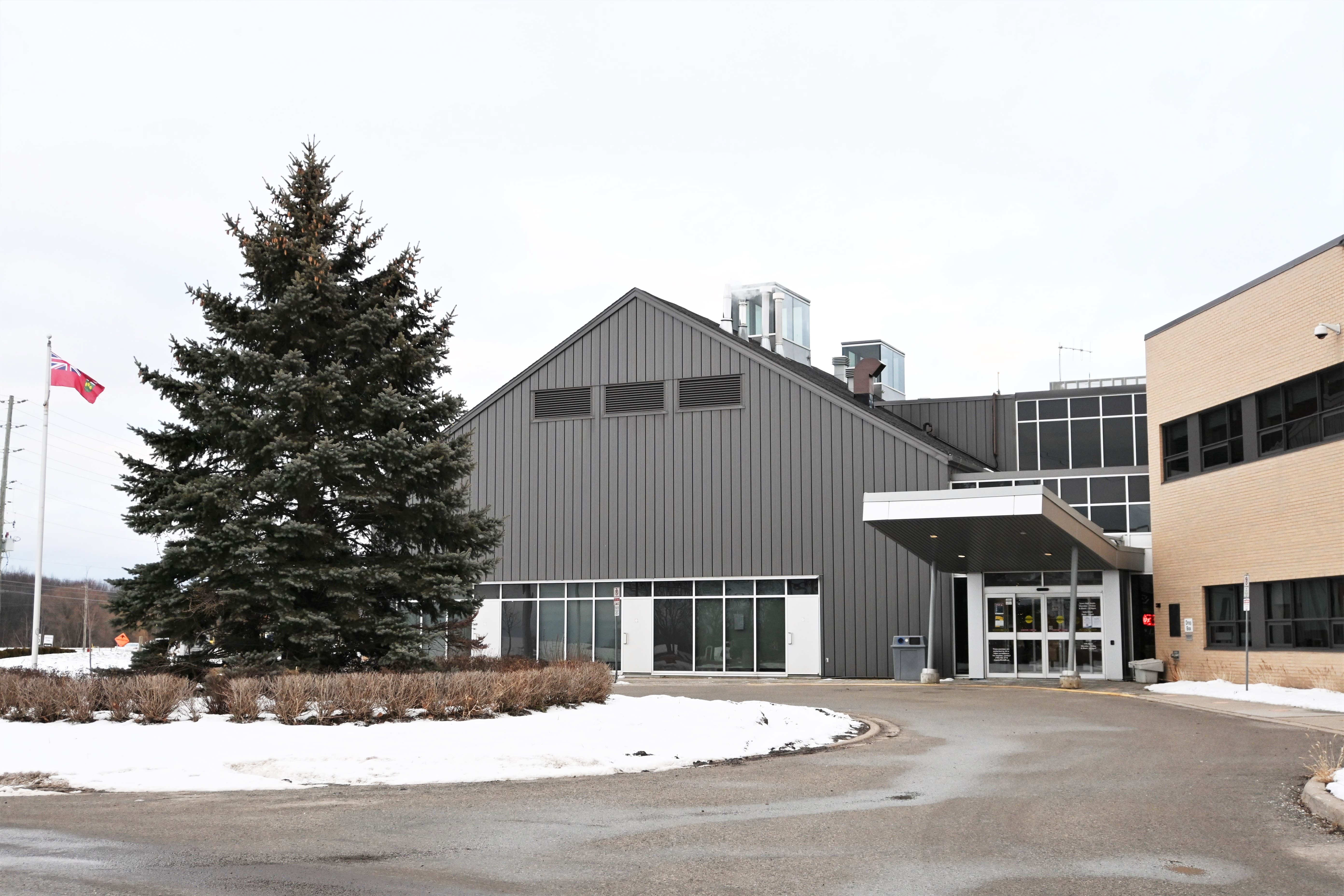
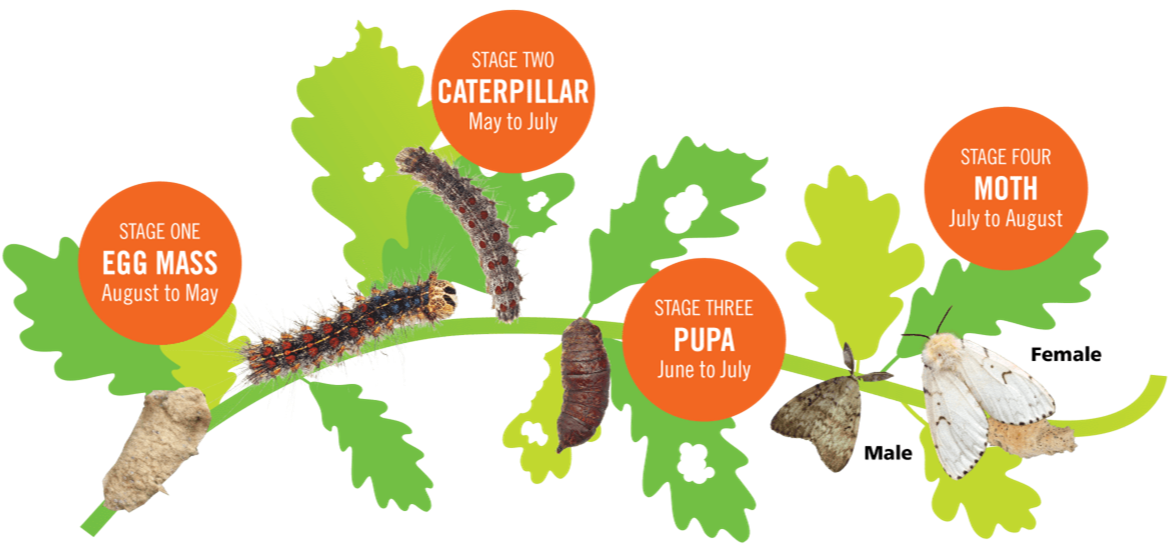 The spongy moth has four life stages: egg, caterpillar, pupa, and moth.
The spongy moth has four life stages: egg, caterpillar, pupa, and moth.